Gallery of additional pictures
Gallery 3: May 1977 - June 2011
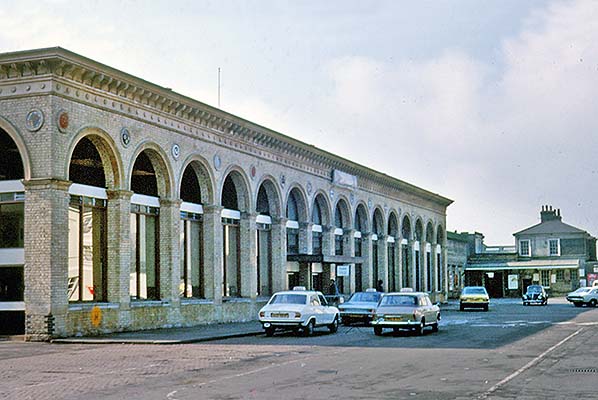 Cambridge station forecourt in May 1977. Apart from signage, including the small but adequate British Rail sign over the entrance, and the hotch-potch of taxis, little has changed over the previous decade. The bus terminus is now off the picture to the right, however. instead of in its former position beside the GNR building in the background.
Cambridge station forecourt in May 1977. Apart from signage, including the small but adequate British Rail sign over the entrance, and the hotch-potch of taxis, little has changed over the previous decade. The bus terminus is now off the picture to the right, however. instead of in its former position beside the GNR building in the background.
Photo by Alan Young
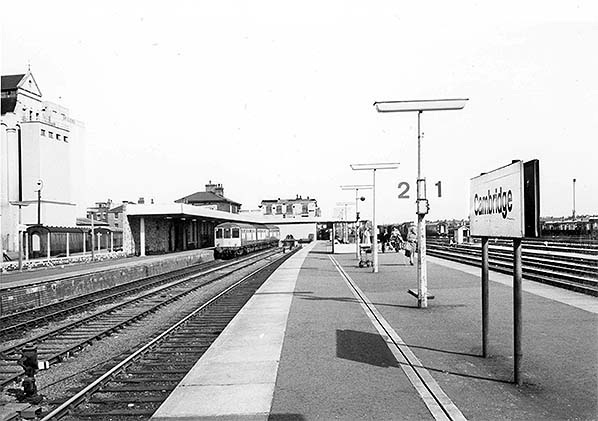 Two views taken moments apart in March 1979 and looking north from platforms 1/2. In platform 3, left, sits a 3-car BRC&W DMU; this is a Norwich based unit and was probably working the Bishop's Stortford shuttle. A Class 37 locomotive sits in the carriage sidings while on the right an assortment of goods wagons and brake vans can be seen in the goods yard. In the upper image, a Gresley vehicle can be seen in the dock road behind platform 3. It is in departmental use and has a largely unreadable inscription on its end. The functional but quite repulsive waiting shelters are evident in the second image. The former GNR station building stands, as it continues to do in 2015, behind the DMU. The leading vehicle of the DMU is a composite; the first class accommodation being signified by the yellow line above the first two windows behind the driving cab. These units, Class 104, were extremely basic internally even by general DMU standards. Original deliveries, from 1957 onwards, comprised 2, 3 and 4-car units and internal layout varied among the class. Some, for example, had first class located in the centre car and the location of the guard's compartment also varied. Both Class 104 and the updated 'Calder Valley' Class 110 variant were familiar at Cambridge long before any were based in the area as they appeared on services from Birmingham and from Yorkshire via the GN&GE Joint line. Some members of Class 104 ended up based at Norwich and Stratford but none were ever allocated to Cambridge as far as is known.
Two views taken moments apart in March 1979 and looking north from platforms 1/2. In platform 3, left, sits a 3-car BRC&W DMU; this is a Norwich based unit and was probably working the Bishop's Stortford shuttle. A Class 37 locomotive sits in the carriage sidings while on the right an assortment of goods wagons and brake vans can be seen in the goods yard. In the upper image, a Gresley vehicle can be seen in the dock road behind platform 3. It is in departmental use and has a largely unreadable inscription on its end. The functional but quite repulsive waiting shelters are evident in the second image. The former GNR station building stands, as it continues to do in 2015, behind the DMU. The leading vehicle of the DMU is a composite; the first class accommodation being signified by the yellow line above the first two windows behind the driving cab. These units, Class 104, were extremely basic internally even by general DMU standards. Original deliveries, from 1957 onwards, comprised 2, 3 and 4-car units and internal layout varied among the class. Some, for example, had first class located in the centre car and the location of the guard's compartment also varied. Both Class 104 and the updated 'Calder Valley' Class 110 variant were familiar at Cambridge long before any were based in the area as they appeared on services from Birmingham and from Yorkshire via the GN&GE Joint line. Some members of Class 104 ended up based at Norwich and Stratford but none were ever allocated to Cambridge as far as is known.
Photos by John Mann
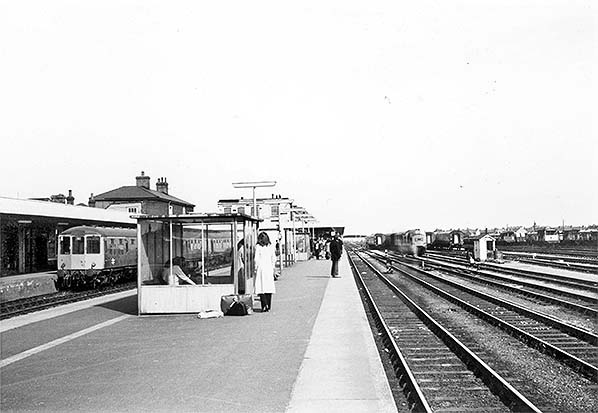
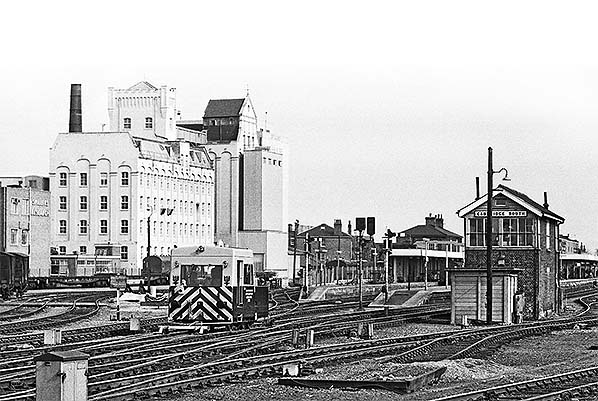 In April 1979 a Matisa track recording trolley trundles into Cambridge station. BR purchased thirteen of these from Matisa, Switzerland. Dating from 1959, they were BR's first excursion into the recording of track geometry whilst on the move. The advantage of a lightweight trolley type vehicle was that track geometry could be recorded 'as it was' as opposed to when heavier vehicles passed over it causing deflections. Due to the trident devices on the rear of the cab and sometimes also on the cab doors, the trolleys gained the name 'Neptune'. Recording could be accomplished at 15mph and the trolleys could run light to where they were required at a maximum speed of 40mph. Any piece of track needing attention was automatically given a splash of paint. Neptunes would often be seen running bearing a small headcode plate. They gave good service for many years until displaced by more modern machines with advanced technology. At least one survives in preservation. One of them, probably that seen above, was for many years a familiar sight stabled in Coalfield sidings behind platform 3. In the background, to the left of Neptune, E88519E can be seen. This carriage was stabled here for many years but what it was used for is not known. Possible it was used as a mess or office as a set of wooden steps could often be seen giving access to one of its doors. At the time the above photograph was taken, the railway scene at Cambridge was very bland. The station was unwelcoming and clinical while, Liverpool Street trains excepted, most services were operated by DMUs. There was still some freight traffic, however, plus occasional ECML diversions. At least it was still British Rail with its sensible and easy to understand ticket system and corporate image which gave a feeling of familiarity and reassurance wherever one went.
In April 1979 a Matisa track recording trolley trundles into Cambridge station. BR purchased thirteen of these from Matisa, Switzerland. Dating from 1959, they were BR's first excursion into the recording of track geometry whilst on the move. The advantage of a lightweight trolley type vehicle was that track geometry could be recorded 'as it was' as opposed to when heavier vehicles passed over it causing deflections. Due to the trident devices on the rear of the cab and sometimes also on the cab doors, the trolleys gained the name 'Neptune'. Recording could be accomplished at 15mph and the trolleys could run light to where they were required at a maximum speed of 40mph. Any piece of track needing attention was automatically given a splash of paint. Neptunes would often be seen running bearing a small headcode plate. They gave good service for many years until displaced by more modern machines with advanced technology. At least one survives in preservation. One of them, probably that seen above, was for many years a familiar sight stabled in Coalfield sidings behind platform 3. In the background, to the left of Neptune, E88519E can be seen. This carriage was stabled here for many years but what it was used for is not known. Possible it was used as a mess or office as a set of wooden steps could often be seen giving access to one of its doors. At the time the above photograph was taken, the railway scene at Cambridge was very bland. The station was unwelcoming and clinical while, Liverpool Street trains excepted, most services were operated by DMUs. There was still some freight traffic, however, plus occasional ECML diversions. At least it was still British Rail with its sensible and easy to understand ticket system and corporate image which gave a feeling of familiarity and reassurance wherever one went.
Photo by Kevin Lane from his Flickr photostream
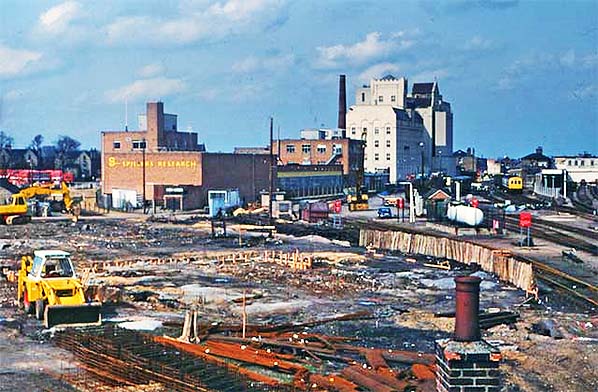 Where Messrs Coote & Warren's coal staithes had stood decaded previously, in April 1979 the area is being cleared in preparation for building Cambridge PSB (Power Signal Box). The track on the right, passing behind the stockade, headed towards the Spillers Research building and then turned north-east to serve the loading bay at the front of the mill. There was, back in the dim and distant past, a track running through the mill and into the GNR goods yard. It was connected at both ends via wagon turntables. The former GNR goods yard (not to be confused with the GNR goods shed east of the main line) was located where the Eastern Counties buses can be seen in the left background. It had a coal yard, small goods shed and cattle pens The Hills Road bus garage, which dated from Ortona days, had insufficient capacity to house the whole Cambridge fleet as the fleet expanded and the physical size of buses increased so Eastern Counties rented part of the former goods yard site. This arrangement had been in operation for some 40 years and access for buses was via Station Road and what is now Warren Close, the one-time commercial entrance to the goods yard. The public entrance was on Hills Road, opposite Brooklands Avenue. A rather mysterious story surrounds the GNR goods yard. When the tramway opened in October 1880 the depot on East Road was yet to be opened and it eventually did so in January 1881. At least two authors have said that in the interim, tramcars and horses were housed overnight in the GNR goods yard. The problem with this version of events is that a tramway spur would need to have been laid from Station Road into the GNR goods yard and whilst your author is not saying this is untrue, no contemporary evidence of such an arrangement has come to light. The cost and legalities of setting into the road a set of points and perhaps 200yds of track into railway premises would make this short term solution rather unlikely. What is more likely is that tramcars were simply left on Station Road overnight (there was only six cars at the outset) and horses were stabled in the GNR goods yard but, as said, in the absence of evidence the truth may have to remain a mystery.
Where Messrs Coote & Warren's coal staithes had stood decaded previously, in April 1979 the area is being cleared in preparation for building Cambridge PSB (Power Signal Box). The track on the right, passing behind the stockade, headed towards the Spillers Research building and then turned north-east to serve the loading bay at the front of the mill. There was, back in the dim and distant past, a track running through the mill and into the GNR goods yard. It was connected at both ends via wagon turntables. The former GNR goods yard (not to be confused with the GNR goods shed east of the main line) was located where the Eastern Counties buses can be seen in the left background. It had a coal yard, small goods shed and cattle pens The Hills Road bus garage, which dated from Ortona days, had insufficient capacity to house the whole Cambridge fleet as the fleet expanded and the physical size of buses increased so Eastern Counties rented part of the former goods yard site. This arrangement had been in operation for some 40 years and access for buses was via Station Road and what is now Warren Close, the one-time commercial entrance to the goods yard. The public entrance was on Hills Road, opposite Brooklands Avenue. A rather mysterious story surrounds the GNR goods yard. When the tramway opened in October 1880 the depot on East Road was yet to be opened and it eventually did so in January 1881. At least two authors have said that in the interim, tramcars and horses were housed overnight in the GNR goods yard. The problem with this version of events is that a tramway spur would need to have been laid from Station Road into the GNR goods yard and whilst your author is not saying this is untrue, no contemporary evidence of such an arrangement has come to light. The cost and legalities of setting into the road a set of points and perhaps 200yds of track into railway premises would make this short term solution rather unlikely. What is more likely is that tramcars were simply left on Station Road overnight (there was only six cars at the outset) and horses were stabled in the GNR goods yard but, as said, in the absence of evidence the truth may have to remain a mystery.
Photo by Geoffrey Skelsey
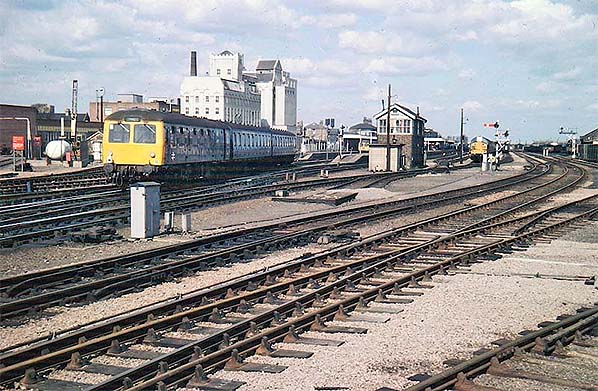 A hybrid 3-car DMU arrives at Cambridge from Kings Cross in September 1979. It is formed of two Class 116 suburban vehicles and a Cravens Class 106 vehicle. Class 116 was predominantly a Western Region type but a few sets had been transferred to King's Cross suburban services as part of a scheme to convert all King's Cross - Hitchin/Royston/Cambridge stopping services to DMU in order to get rid of the 'block ender' non corridor loco hauled stock. In the event, insufficient DMU sets were made available so the 'block enders' soldiered on alongside Cravens, the few Class 116s, the hopeless ex Lea Valley Class 125s and a couple of non-buffet Mk1 corridor sets. Local management must have insisted upon suburban DMUs in their quest as a number of other types were available at the time. The few Class 116 sets were, like the Cravens, allocated on paper to Finsbury Park but in practice were diagrammed from and maintained at Cambridge. The hydraulic Class 125s continued to be maintained (or bodged up) at Stratford. One Class 116 power car will have been out of service for repairs, hence the Cravens car deputising. This situation was not uncommon and highlights well the advantage of compatible coupling codes. Spillers mill looks nice and clean, chimney excepted, and appears to have received a paint job. On the right, centre distance, the points giving access from the down goods loop to the down goods yard can be seen. The track at bottom right is that from the up goods yard. Both were marshalling and holding yards only.
A hybrid 3-car DMU arrives at Cambridge from Kings Cross in September 1979. It is formed of two Class 116 suburban vehicles and a Cravens Class 106 vehicle. Class 116 was predominantly a Western Region type but a few sets had been transferred to King's Cross suburban services as part of a scheme to convert all King's Cross - Hitchin/Royston/Cambridge stopping services to DMU in order to get rid of the 'block ender' non corridor loco hauled stock. In the event, insufficient DMU sets were made available so the 'block enders' soldiered on alongside Cravens, the few Class 116s, the hopeless ex Lea Valley Class 125s and a couple of non-buffet Mk1 corridor sets. Local management must have insisted upon suburban DMUs in their quest as a number of other types were available at the time. The few Class 116 sets were, like the Cravens, allocated on paper to Finsbury Park but in practice were diagrammed from and maintained at Cambridge. The hydraulic Class 125s continued to be maintained (or bodged up) at Stratford. One Class 116 power car will have been out of service for repairs, hence the Cravens car deputising. This situation was not uncommon and highlights well the advantage of compatible coupling codes. Spillers mill looks nice and clean, chimney excepted, and appears to have received a paint job. On the right, centre distance, the points giving access from the down goods loop to the down goods yard can be seen. The track at bottom right is that from the up goods yard. Both were marshalling and holding yards only.
Photo by Geoffrey Skelsey
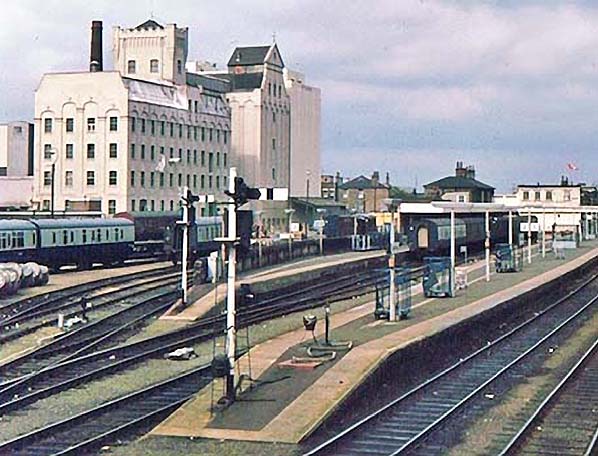 A view of the south bay of Cambridge station in September 1979. The view is from Cambridge South signal box on a rather stormy day and the scene typifies just how boring Cambridge station was at this time from an enthusiast point of view. Most services were DMU-operated and the only through services to London were to Liverpool Street and in the off-peak period even those were infrequent by modern standards. One thing of perhaps vague interest is the retention of water facilities at the end of the platform, complete with brazier to prevent pipes from freezing in the winter. Before the widespread introduction of electric train heating, some diesel locomotives were fitted with steam heating boilers - the tanks for which required topping up.
A view of the south bay of Cambridge station in September 1979. The view is from Cambridge South signal box on a rather stormy day and the scene typifies just how boring Cambridge station was at this time from an enthusiast point of view. Most services were DMU-operated and the only through services to London were to Liverpool Street and in the off-peak period even those were infrequent by modern standards. One thing of perhaps vague interest is the retention of water facilities at the end of the platform, complete with brazier to prevent pipes from freezing in the winter. Before the widespread introduction of electric train heating, some diesel locomotives were fitted with steam heating boilers - the tanks for which required topping up.
Photo by Geoffrey Skelsey
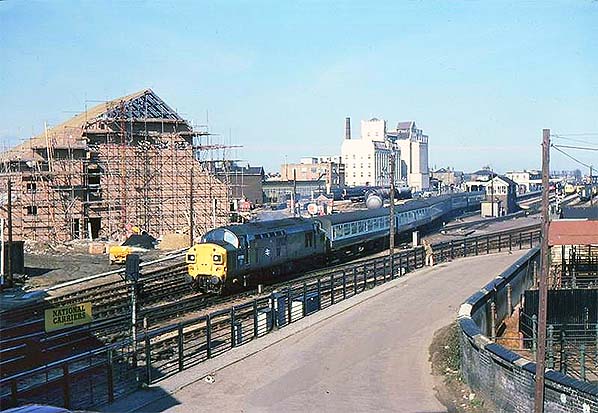 On 11 March 1980 Class 37 No.37052 snorts out of Cambridge with the 13:26 to Liverpool Street. English Electric locomotives had a habit of responding slowly to the power controller and then, after a pause, suddenly erupting. Class 37 was a familiar sight at Cambridge emitting a loud snort and cloud of smoke before, a few seconds later, starting to move. A Metro-Cammell DMU can be seen in the carriage sidings and this scene was about as exciting as Cambridge station got at this time. On the left, the carbuncular PSB is taking shape and a number of tank wagons are stabled in Coalfield sidings. Spillers mill just about survives today but the research building does not. The locomotive began life as D6752 and ended up as 37713. It is not among the survivors, being scrapped in June 2007.
On 11 March 1980 Class 37 No.37052 snorts out of Cambridge with the 13:26 to Liverpool Street. English Electric locomotives had a habit of responding slowly to the power controller and then, after a pause, suddenly erupting. Class 37 was a familiar sight at Cambridge emitting a loud snort and cloud of smoke before, a few seconds later, starting to move. A Metro-Cammell DMU can be seen in the carriage sidings and this scene was about as exciting as Cambridge station got at this time. On the left, the carbuncular PSB is taking shape and a number of tank wagons are stabled in Coalfield sidings. Spillers mill just about survives today but the research building does not. The locomotive began life as D6752 and ended up as 37713. It is not among the survivors, being scrapped in June 2007.
Photo by Chris Turnbull
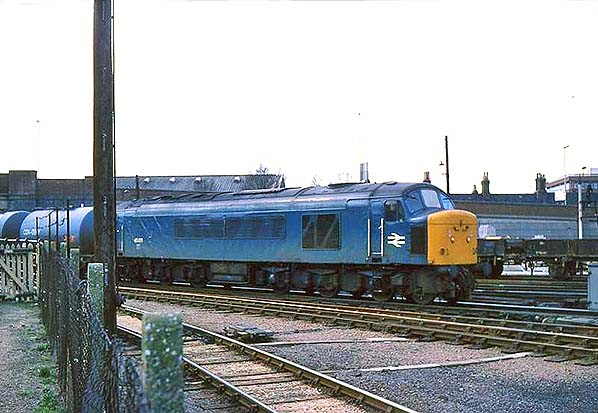
The 'Peaks', the name under which classes 44/45/46 were all lumped under, were not a type readily associated with Cambridge but nonetheless they were by no means rare. King's Cross would often 'kick out' a Class 46 and send it to Cambridge on a fill-in turn, while Class 45 members could appear on freight. Others appeared from time to time on passenger trains from the Midlands before these services became almost exclusively DMUs. Class 44, from which the 'Peak' name derived was, as far as is known, never to appear at Cambridge although the class was a common sight at March. Above, class 45 No.45071 arrives at Cambridge on 26 March 1980. It has come from the Ciba-Geigy plant at Duxford. The plant, then known locally as simply 'Ciba', is long-established and located on the southern edge of Duxford village. If you have ever used Araldite, this plant is where it came from. In response to concerns about hazardous chemicals being transferred from railhead to plant by road, a spur was built direct to the plant in the 1970s. It branched off just south of Whittlesford via trailing points from the down Liverpool Street - Cambridge line. at the southern edge of the plant, the single track spur, which incorporated a level crossing, fanned out into three sidings. A fourth siding branched off the southernmost of the three sidings and headed northwards into the bowels of the plant, crossing the other two sidings in the process. Unfortunately the spur was to have a short life as it fell victim to the abandonment of BR's Speedlink service in 1991. At the time of writing the spur is intact but disused and overgrown. The Duxford plant is still in use but now manufactures pharmaceuticals and the Ciba-Geigy name is defunct following a series of mergers. Some photographs of the disused spur can be seen here. Originally D125, 45071 was among the earlier Class 45 withdrawals and bowed out in July 1981.
Photo by Chris Turnbull
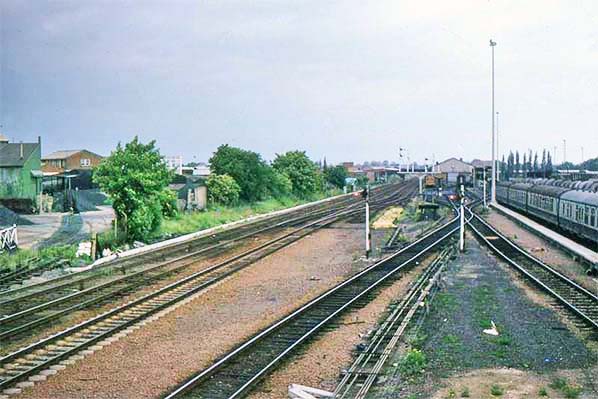 A unusual view looking north from Coldham Lane Junction signal box in June 1981. This was during a visit to various Cambridge signal boxes by members of the Cambridge Railway Circle just prior to the boxes' demise. In the distance Cambridge diesel depot can be seen. A Class 08 shunter can be seen while on the right is a rake of Mk1 carriages and behind them a rake of tank wagons. In the right background the floodlights of Cambridge United FC's Abbey Stadium are seen. On the left is the rarely photographed siding, complete with gate, into the Co-op coal yard. The connection was removed c.1985.
A unusual view looking north from Coldham Lane Junction signal box in June 1981. This was during a visit to various Cambridge signal boxes by members of the Cambridge Railway Circle just prior to the boxes' demise. In the distance Cambridge diesel depot can be seen. A Class 08 shunter can be seen while on the right is a rake of Mk1 carriages and behind them a rake of tank wagons. In the right background the floodlights of Cambridge United FC's Abbey Stadium are seen. On the left is the rarely photographed siding, complete with gate, into the Co-op coal yard. The connection was removed c.1985.
Photo by Chris Turnbull
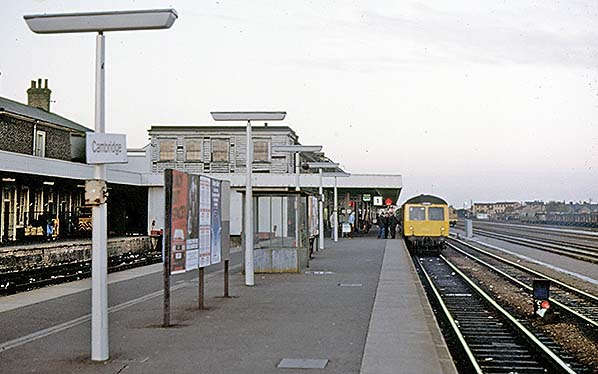
In October 1981 a Cravens DMU waits at platform 1 with the shuttle service to Bishop's Stortford. This is a Norwich-based DMU, indicated by the set number displayed at the top of the windscreen. Just to the right of the DMU a Class 08 shunter can be seen. The carriage sidings, or what can be seen of them, are empty but there is still some goods activity, far right. On platform 3, left, one of battery operated tractors used for towing BRUTE trolleys around the station can be seen. With the bay platform devoid of trains, we get an idea of what the platform side of the former GNR station building looked like.
Photo by Alan Young
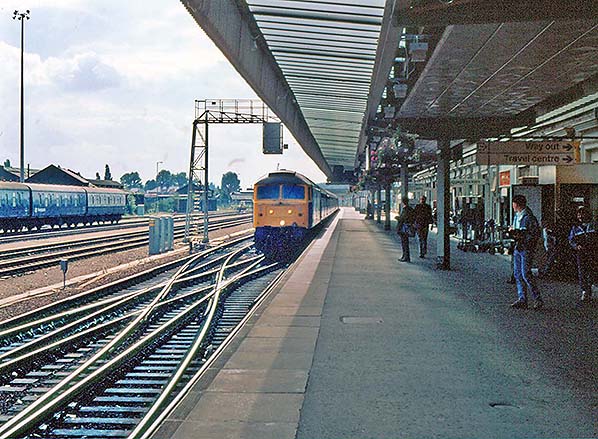 On 22 September 1984 a Class 47 arrives at Cambridge with a passenger train. Unfortunately we have no further information but as the locomotive has already encroached upon the scissors crossing, the train is probably for King's Lynn and will stop at platform 4. The lack of a surge of passengers on platform 1 may bear out this supposition. The entrance/exit from the platforms is just to the photographer's right. The locomotive is about to pass over the point where the long-forgotten subway (or 'luggage tunnel') passes beneath the track. This subway connected the booking office to the original 19th century island platform and was rediscovered, as was the island platform foundations, during some 1981 track alterations. The subway still exists but is thought to be partially, if not wholly, infilled. The locomotive has two marker lights in place of the original headcode box and has been given a high intensity headlamp. This period was the beginning of the health and safety mania which rules life today, although high intensity headlamps cannot be said to be a bad idea. Their purpose is to make approaching trains more visible from a distance. A parcels train can be seen stabled on the left. Parcels trains were prolific at Cambridge for many years and latterly converted diesel and electric multiple units became the order of the day as well as the purpose-built Gloucester RC&W
On 22 September 1984 a Class 47 arrives at Cambridge with a passenger train. Unfortunately we have no further information but as the locomotive has already encroached upon the scissors crossing, the train is probably for King's Lynn and will stop at platform 4. The lack of a surge of passengers on platform 1 may bear out this supposition. The entrance/exit from the platforms is just to the photographer's right. The locomotive is about to pass over the point where the long-forgotten subway (or 'luggage tunnel') passes beneath the track. This subway connected the booking office to the original 19th century island platform and was rediscovered, as was the island platform foundations, during some 1981 track alterations. The subway still exists but is thought to be partially, if not wholly, infilled. The locomotive has two marker lights in place of the original headcode box and has been given a high intensity headlamp. This period was the beginning of the health and safety mania which rules life today, although high intensity headlamps cannot be said to be a bad idea. Their purpose is to make approaching trains more visible from a distance. A parcels train can be seen stabled on the left. Parcels trains were prolific at Cambridge for many years and latterly converted diesel and electric multiple units became the order of the day as well as the purpose-built Gloucester RC&W
motor parcels vans
Photo by Alan Young
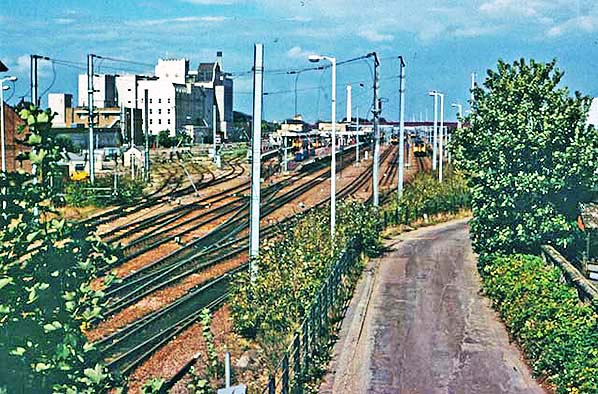 This view, from Hills Road bridge, dates from September 1994. Electric multiple units had long since ruled by the time this photograph was taken. Most EMUs visible are of Class 317 but a Class 315 lurks in platform 2. After the introduction to service of Class 379 in 2011 a number of additional Class 317 units became available, so the toiletless Class 315 became rare at Cambridge. The gault brick Spillers Mill, left background, was destined to be badly damaged by fire on 27 March 2010. Ahead of the camera is the former access road to the goods sheds, for decades a favourite hang-out for railway enthusiasts but now serving the retail and leisure park built on the site of the sheds and cattle market. Part of the wall of the former cattle market is visible on the right but much greenery is encroaching upon the scene. The area has since been considerably tidied up.
This view, from Hills Road bridge, dates from September 1994. Electric multiple units had long since ruled by the time this photograph was taken. Most EMUs visible are of Class 317 but a Class 315 lurks in platform 2. After the introduction to service of Class 379 in 2011 a number of additional Class 317 units became available, so the toiletless Class 315 became rare at Cambridge. The gault brick Spillers Mill, left background, was destined to be badly damaged by fire on 27 March 2010. Ahead of the camera is the former access road to the goods sheds, for decades a favourite hang-out for railway enthusiasts but now serving the retail and leisure park built on the site of the sheds and cattle market. Part of the wall of the former cattle market is visible on the right but much greenery is encroaching upon the scene. The area has since been considerably tidied up.
Photo by Geoffrey Skelsey
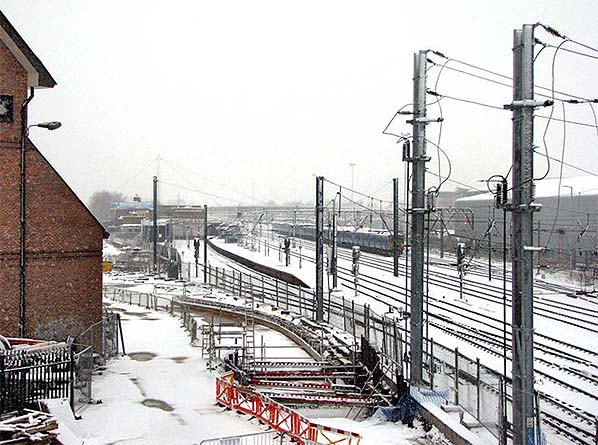 Easter Sunday 23 March 2008 and there is not a bunny or chocolate egg to be seen at Cambridge South. There is however, as if to compensate, some snow. Apart from the line of stabled Class 317 EMUs, there is no sign of any other activity and the tracks in the south bay are largely covered by snow. The reason was engineering work. On that and the following day, buses replaced trains between Dullingham and Cambridge, Audley End and Cambridge, Royston and Ely. On the right is the Royal Mail building, largely on the site of the former GER goods shed. On the left part of Cambridge power signal box (PSB) can be seen. At the time of writing, Cambridge PSB is planned to be phased out and control transferred to Romford. In the centre foreground, work has begun on the southern stretch of the years late and massively over-budget guided busway.
Easter Sunday 23 March 2008 and there is not a bunny or chocolate egg to be seen at Cambridge South. There is however, as if to compensate, some snow. Apart from the line of stabled Class 317 EMUs, there is no sign of any other activity and the tracks in the south bay are largely covered by snow. The reason was engineering work. On that and the following day, buses replaced trains between Dullingham and Cambridge, Audley End and Cambridge, Royston and Ely. On the right is the Royal Mail building, largely on the site of the former GER goods shed. On the left part of Cambridge power signal box (PSB) can be seen. At the time of writing, Cambridge PSB is planned to be phased out and control transferred to Romford. In the centre foreground, work has begun on the southern stretch of the years late and massively over-budget guided busway.
Photo by John Sutton, reproduced from Geograph under creative commons licence
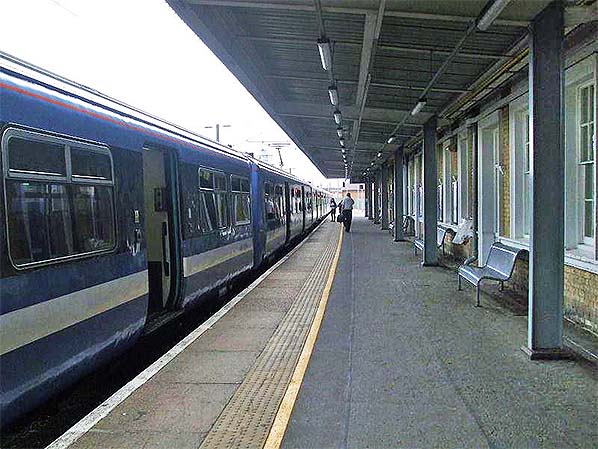 Looking south along platform 3 in July 2009. The train is either a Class 317 or 321. The platform and the building on the right were once the Great Northern Railway station and it had its own booking office, waiting rooms, cab rank and so on. There was probably also stationmaster's accommodation but this particular detail has proved elusive. Readers will recall from earlier in the Cambridge feature that all pre-grouping companies which served Cambridge had their own stationmaster. In 2009 the platform side of the building was considerably smarter than it was during the BR era when it was something of a forgotten corner of Cambridge station. Beyond the end of the platform part of the power signal box can be seen. Today, the odd situation prevails whereby the guided busway passes between the signal box and the railway tracks.
Looking south along platform 3 in July 2009. The train is either a Class 317 or 321. The platform and the building on the right were once the Great Northern Railway station and it had its own booking office, waiting rooms, cab rank and so on. There was probably also stationmaster's accommodation but this particular detail has proved elusive. Readers will recall from earlier in the Cambridge feature that all pre-grouping companies which served Cambridge had their own stationmaster. In 2009 the platform side of the building was considerably smarter than it was during the BR era when it was something of a forgotten corner of Cambridge station. Beyond the end of the platform part of the power signal box can be seen. Today, the odd situation prevails whereby the guided busway passes between the signal box and the railway tracks.
Photo by Sunil060902, reproduced from Wikimedia Commons under creative commons licence
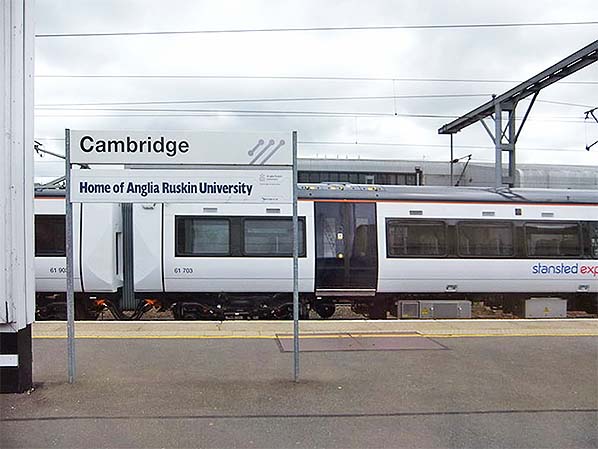 A running-in board on Platform 1/2 seen in June 2011. One hopes this sort of thing does not become widespread; with Cambridge receiving many foreign visitors who may not have English as their primary language, signs such as this could be a source of confusion. The train is a Class 379 Electrostar EMU. There is nothing unusual about a stansted express, to use the illiterate, non capitalised spelling, branded unit at Cambridge. Stansted Express units of Classes 317 and 379 (and, earlier, Class 321) are used indiscriminately on Stansted Airport and Cambridge services. Apart from the experimental OLE/battery unit, Class 379 operates only on the Liverpool Street - Stansted Airport/Cambridge line at the time of writing. They can, however, also appear on the limited peak hour services which continue, or start from, north from Cambridge.
A running-in board on Platform 1/2 seen in June 2011. One hopes this sort of thing does not become widespread; with Cambridge receiving many foreign visitors who may not have English as their primary language, signs such as this could be a source of confusion. The train is a Class 379 Electrostar EMU. There is nothing unusual about a stansted express, to use the illiterate, non capitalised spelling, branded unit at Cambridge. Stansted Express units of Classes 317 and 379 (and, earlier, Class 321) are used indiscriminately on Stansted Airport and Cambridge services. Apart from the experimental OLE/battery unit, Class 379 operates only on the Liverpool Street - Stansted Airport/Cambridge line at the time of writing. They can, however, also appear on the limited peak hour services which continue, or start from, north from Cambridge.
Photo by Rept0n1x, reproduced from Wikimedia Commons under creative commons licence
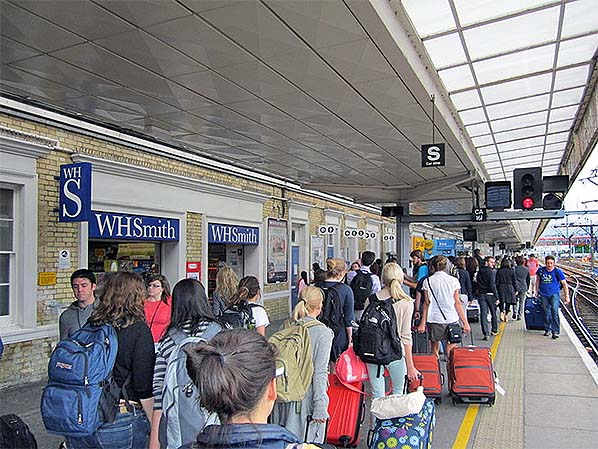 Looking along platform 4 from the north end of platform 1 in June 2011. There are plenty of 'rumble trolleys' visible including one in an embarrassing floral livery which is, no doubt, easy to spot on the airport luggage carousel. The 'S Car Stop' sign informs drivers where they should stop their trains irrespective of train length. The plate showing CA 151 is the number of the adjacent signal, CA being Cambridge. Despite being widened throughout the life of the station, it is evident that the platform is still quite narrow and more so if we allow for the painted line behind which passengers are supposed to stand when a train is approaching. It should be remembered that in 1845 this was the east colonnade through which trains ran; there was a ridiculously narrow platform against the wall on the left and where the photographer is standing, a track once ran along the outside of the colonnade. What was the W H Smith bookstall for many decades is now a walk-in shop. W H Smith dates back to 1792 and became the first chain store in the world. Their first railway station bookstall appeared at Euston in 1848. At that time, books were priced beyond the reach of most people so Smith decided to find a way of providing books cheaply. This was a success, the result being what we know today as the 'paperback'. W H Smith had a presence at Cambridge station from 1854, if not earlier. Their original stall was further along the platform, adjacent to (or in Eastern Counties Railway wording 'opposite') the ladies waiting room. It was relocated to the site seen above in 1859 but has expanded considerably in order to become a walk-in shop. During the 1850s the Eastern Counties Railway was at constant loggerheads with Smith due to unpaid, or overdue, rent. Smith had its wares delivered to its bookstalls by the most obvious means, train, but over and above the rental problems there were further problems concerning payments to the railway company for deliveries. Surviving records suggest the latter problem resulted from genuine misunderstandings over what were rental payments and what were delivery charges. Indeed, this could have been at least in part responsible for both problems. Whatever was behind it all, things appear to have been settled amicably by the end of the decade.
Looking along platform 4 from the north end of platform 1 in June 2011. There are plenty of 'rumble trolleys' visible including one in an embarrassing floral livery which is, no doubt, easy to spot on the airport luggage carousel. The 'S Car Stop' sign informs drivers where they should stop their trains irrespective of train length. The plate showing CA 151 is the number of the adjacent signal, CA being Cambridge. Despite being widened throughout the life of the station, it is evident that the platform is still quite narrow and more so if we allow for the painted line behind which passengers are supposed to stand when a train is approaching. It should be remembered that in 1845 this was the east colonnade through which trains ran; there was a ridiculously narrow platform against the wall on the left and where the photographer is standing, a track once ran along the outside of the colonnade. What was the W H Smith bookstall for many decades is now a walk-in shop. W H Smith dates back to 1792 and became the first chain store in the world. Their first railway station bookstall appeared at Euston in 1848. At that time, books were priced beyond the reach of most people so Smith decided to find a way of providing books cheaply. This was a success, the result being what we know today as the 'paperback'. W H Smith had a presence at Cambridge station from 1854, if not earlier. Their original stall was further along the platform, adjacent to (or in Eastern Counties Railway wording 'opposite') the ladies waiting room. It was relocated to the site seen above in 1859 but has expanded considerably in order to become a walk-in shop. During the 1850s the Eastern Counties Railway was at constant loggerheads with Smith due to unpaid, or overdue, rent. Smith had its wares delivered to its bookstalls by the most obvious means, train, but over and above the rental problems there were further problems concerning payments to the railway company for deliveries. Surviving records suggest the latter problem resulted from genuine misunderstandings over what were rental payments and what were delivery charges. Indeed, this could have been at least in part responsible for both problems. Whatever was behind it all, things appear to have been settled amicably by the end of the decade.
Photo by Rept0n1x, reproduced from Wikimedia Commons under creative commons licence
Return to Cambridge home page

